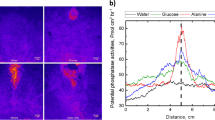Abstract
A pot experiment was designed to evaluate the interactive effects of multifunctional microbial inoculation treatments and rock phosphate (RP) application on N and P uptake by alfalfa through the use of 15N and 32P isotopic dilution approaches. The microbial inocula consisted of a wild type (WT) Rhizobium meliloti strain, the arbuscular mycorrhizal (AM) fungus Glomus mosseae (Nicol. and Gerd.) Gerd. and Trappe, and a phosphate solubilizing rhizobacterium (Enterobacter sp.). Inoculated microorganisms were established in the root tissues and/or in the rhizosphere soil of alfalfa plants (Medicago sativa L.). Improvements in N and P accumulation in alfalfa corroborate beneficial effects of Rhizobium and AM interactions. Inoculation with selected rhizobacteria improved the AM effect on N or P accumulation in both the RP-added soil and in the non RP-amended controls. Measurements of the 15N/14N ratio in plant shoots indicate an enhancement of the N2 fixation rates in Rhizobium-inoculated AM-plants, over that achieved by Rhizobium in non-mycorrhizal plants. Whether or not RP was added, AM-inoculated plants showed a lower specific activity (32P/31P) than did their comparable non-mycorrhizal controls, suggesting that the plant was using otherwise unavailable P sources. The phosphate-solubilizing, AM-associated, microbiota could in fact release phosphate ions, either from the added RP or from the indigenous ``less-available'' soil phosphate. A low Ca concentrations in the test soil may have benefited P solubilization. Under field conditions, the inoculation with AM fungi significantly increased plant biomass and N and P accumulation in plant tissues. Phosphate-solubilizing rhizobacteria improved mycorrhizal responses in soil dually receiving RP and organic matter amendments. Organic matter addition favoured RP solubilization. This, together with a tailored microbial inoculation, increased the agronomic efficiency of RP in the test soil that was Ca deficient at neutral pH.
Similar content being viewed by others
References
Barea JM, Azcón R & Azcón-Aguilar C (1983) Interactions between phosphate solubilizing bacteria and VA mycorrhiza to improve plant utilization of rock phosphate in non acidic soils. In: 3rd International Congress on Phosphorus Compounds, pp 127–144. Brussels October 4–6
Barea JM, Azcón-Aguilar C & Azcón R (1997) Interactions between mycorrhizal fungi and rhizosphere microorganisms within the context of sustainable soil-plant systems. In: Multitrophic Interactions in Terrestrial Systems, pp 65–77. Cambridge: Blackwell Science
Barea JM & Jeffries P (1995) Arbuscular mycorrhizas in sustainable soil plant systems In: Mycorrhiza Structure Function Molecular Biology and Biotechnology, pp 521–559. Heidelberg: Springer-Verlag
Bethlenfalvay GJ & Linderman RG (1992) Mycorrhizae in Sustainable Agriculture. ASA Spec Publ Madison WI
Bohlool BB, Ladha JK Garrity DP & George T (1992) Biological nitrogen fixation for sustainable agriculture: a perspective. Plant Soil 141: 1–11
Bolan NSA (1991) critical review on the role of mycorrhizal fungi in the uptake of phosphorus by plants. Plant Soil 134: 189–207
Casanova EF (1995) Agronomic evaluation of fertilizers with special reference to natural and modified phosphate rock. Fert Res 41: 211–218
Danso SKA (1988) The use of 15N enriched fertilizers for estimating nitrogen fixation in grain and pasture legumes In: Nitrogen fixation by Legumes in Mediterranean Agriculture, pp 345–358, Dordrecht: Martinus Nijhoff Publishers
Elvira C, Sampedro L, Benítez E & Nogales R (1998) Vermicomposting of sludges from paper mill and dairy industries with Eisenia andrei: a pilot-scale study. Bio Tech 63: 205–211
Fardeau JC (1993) Le phosphore assimilable des sols: sa représentation par un modèle fonctionnel á plusieurs compartiments. Agron 13: 317–331
Glick BR (1995) The enhancement of plant growth by free-living bacteria. Can J Microbiol 41: 109–117
Hardarson G & Danso SKA (1990) Use of 15N methodology to assess biological nitrogen fixation In: Use of Nuclear Techniques in Studies of Soil-Plant Relationships, pp 129–160. Vienna International Atomic Energy Agency
Jeffries P & Barea JM (1994) Biogeochemical cycling and arbuscular mycorrhizas in the sustainability of plant-soil systems. In: Impact of Arbuscular Mycorrhizas on Sustainable Agriculture and Natural Ecosystem, pp 101–115. Basel: Brikhäuser Verlag
Joner EJ & Jakobsen I (1994) Contribution by two arbuscular mycorrhizal fungi to P uptake by cucumber (Cucumis sativus L) from 32P-labelled organic matter during mineralization in soil. Plant Soil 163: 203–209
Kennedy AC & Smith KL (1995) Soil microbial diversity and the sustainability of agriculture soils. Plant Soil 170: 75–86
Khasawneh FE & Doll EC (1978) The use of phosphate rock for direct application to soils. In: Advances in Agronomy, pp 159–206. New York: Academic Press
Kloepper JW, Zablotowicz RM, Tipping EM & Lifshitz R (1991) Plant growth promotion mediated by bacterial rhizosphere colonizers. In: The Rhizosphere and Plant Growth, pp 315–326. Dordrecht: Kluwer Academic Publishers
Lachica M, Aguilar A & Yañez J (1973) Analisis foliar Métodos utilizados en la Estación Experimental del Zaidín. Anal Edafol Agrobiol 32: 1033–1947
Rajan SSS, Watkinson JH & Sinclair AG (1996) Phosphate rocks for direct application to soils. In: Advances in Agronomy, pp 78–159. New York: Academic Press
Toro M, Azcón R & Barea JM (1997) Improvement of arbuscular mycorrhizal development by inoculation with phosphate-solubilizing rhizobacteria to improve rock phosphate bioavailability (32P) and nutrient cycling. Appl Environ Microbiol 63: 4408–4412
Toro M, Azcón R & Barea J M (1998) The use of isotopic dilution techniques to evaluate the interactive effects of Rhizobium genotype mycorrhizal fungi phosphate-solubizing rhizobacteria and rock phosphate on nitrogen and phosphorus acquisition by Medicago sativa. New Phytol 138: 265–273
Zapata F & Axmann H (1995) 32P isotopic techniques for evaluating the agronomic effectiveness of rock phosphate materials. Fert Res 41: 189–195
Author information
Authors and Affiliations
Corresponding author
Rights and permissions
About this article
Cite this article
Barea, J., Toro, M., Orozco, M. et al. The application of isotopic (32P and 15N) dilution techniques to evaluate the interactive effect of phosphate-solubilizing rhizobacteria, mycorrhizal fungi and Rhizobium to improve the agronomic efficiency of rock phosphate for legume crops. Nutrient Cycling in Agroecosystems 63, 35–42 (2002). https://doi.org/10.1023/A:1020589732436
Issue Date:
DOI: https://doi.org/10.1023/A:1020589732436




